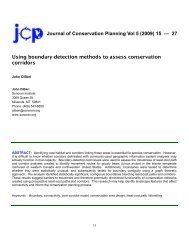Estimating visitor use of protected areas by modeling accessibility: A ...
Estimating visitor use of protected areas by modeling accessibility: A ...
Estimating visitor use of protected areas by modeling accessibility: A ...
Create successful ePaper yourself
Turn your PDF publications into a flip-book with our unique Google optimized e-Paper software.
THEOBALD, NORMAN, NEWMAN / Journal <strong>of</strong> Conservation Planning Vol 6 (2010) 1—20FIGURE 1 A diagram <strong>of</strong> the logic for the<strong>accessibility</strong> model (Theobald 2005).TABLE 2 Weights Used to Reflect theProportion <strong>of</strong> Park Visitors Entering RMNPfrom Each <strong>of</strong> Four Park “Entrance” LocationsEntrance*estimated <strong>by</strong> authors.No. <strong>of</strong>respondentsWeightBeaver Meadows 1,388 0.43Kawaneeche 721 0.22Fall River 1,134 0.34northern* 40 0.01The third step was to model travel time from trailheadsand parking lots, along trails where <strong>visitor</strong>s presumablywould be hiking. The typical velocity <strong>of</strong> a hiker is 5 km/hron flat terrain but diminishes on steeper terrain, and we<strong>use</strong>d a hiking velocity equation (Tobler 1993) to reflectchanges in travel speed as a function <strong>of</strong> trail slope:h = 6*exp(-3.5* |S + 0.05| )where h is the hiking velocity in km/hr and S is the trailslope or gradient. Note that we did not distinguish traveltime based on direction (i.e., hiking up a steep trail mighttake longer than down a steep trail).The fourth step was to incorporate travel time for <strong>of</strong>f-trailhiking. Travel speed was assumed to be the same as ontrail(which includes the slope <strong>of</strong> the terrain being hikedacross), but with an additional decrease in permeability toreflect the difficulty <strong>of</strong> moving through dense vegetationand crossing rivers and lakes. We generalized 46vegetation associations from the fine-grained vegetationdataset (Salas et al. 2005) to 25 classes, and then weestimated a permeability value for each land cover classto reduce the travel speed (1.0 for no effect to 0.0001 fordifficult to move through; Table 3, page 6). Ourpermeability values were based on Frakes et al. (2008),who developed their estimates in consultation with park5



